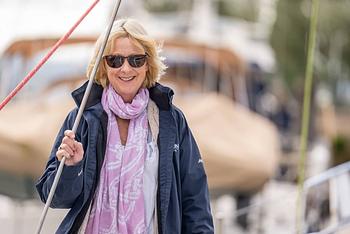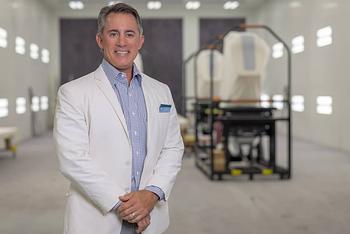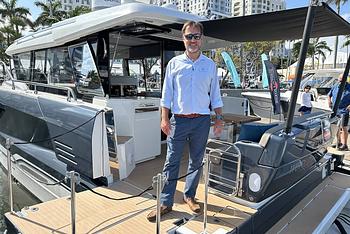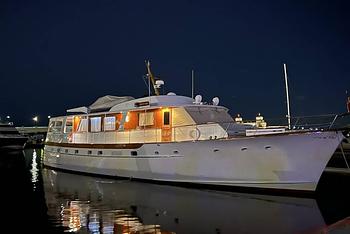Based in Newport, R.I., Jonathan Chapman is a Certified Professional Yacht Broker at the international yacht brokerage firm Worth Avenue Yachts. He has been engaged with the brokerage market for more than 25 years, and during the pandemic, he served as president of the Yacht Brokers Association of America. Earlier in December, between consecutive trips from Rhode Island to Florida and back, he spoke with Rightboat.com content director John Burnham.

Jonathan Chapman
John Burnham
You’ve been a yacht broker for a long time, Jonathan, and you’ve seen the market through many phases. For the benefit of potential buyers and sellers of medium and large size yachts, how would you describe the current marketplace?
Jonathan Chapman
The current marketplace is not what it was a few years ago—we're definitely seeing things slow down. Call it a correction. The COVID era was pretty epic from the standpoint of yacht sales—the busiest time in my 26-year career. And it created a marketplace where whatever price the buyers were asking is what they were getting, or very close to it. The prices in some really competitive markets, such as Hinckleys, were such that buyers were sometimes paying above asking prices. We're now back to where we were before that all began, and we're seeing a number of price corrections. The difference between the asking price and the actual sales price is now typically 10 to 15 percent off. Before, it was under a 5 percent difference for a long time.
Burnham: Are there any sectors of the market that are still hot, where there's strong demand for a type of boat?
Chapman: The market is still hot, John. Buyers and sellers are now negotiating more than they ever had to. We don't do a lot of financing at Worth Avenue Yachts for people that are buying boats with us, but my observation is that higher rates have not really stopped people. There's no lack of interest. There are still buyers who want to buy and sellers who want to sell and move on to their next boat.
Burnham: How about any sectors of the market or types of boats where you can find a boat for a value price?
Chapman: It’s the same story we've had all along. Good clean boats that come to market that are priced reasonably and represented well will sell quickly. Unlike boats that have been on the market for two and three years, which could have some underlying reason due to their condition or age, and typically take a lot longer to sell. Another issue is that the insurance companies are being very tight right now and tough on writing coverage for older boats. Personally, when I've got an older boat under contract and I'm scheduling a survey for that boat, I'm also calling various insurance agents to get that process going well ahead of time, so we don't run into any last-minute difficulties. Generally speaking, the markets are more powerboat focused, so the sailing market offers a lot of value. If you're a sailor and looking for a nice quality sailboat, you're going to get a little more bang for your buck right now.

Linda Marie, 49’ Alden (2005). Courtesy Worth Avenue Yachts
Burnham:
You’ve recently finished up two years as president of the Yacht Brokers Association of America. I’m curious, with your view from that perch, how have you seen yacht brokerage change, and has COVID changed it?
Chapman: I was president of YBAA from its 101st through its 103rd year, which is really quite remarkable. There are very few associations globally that can say they're 100 years old, and I was proud to be involved seeing it into its next century. The yacht brokerage business as a whole changed, particularly in those two years, because they were the COVID years. None of us knew what to expect when COVID hit—I was bracing for what I thought would be a long, lean period of tough sales. But it ended up being this surge, and massive desire for good clean quality boats because the consumer saw it as one of the best ways they could socially distance with their family under their own terms. And it just elevated the brokerage industry to new highs. We have not seen that really slow down, as I think a lot of the experts had predicted—there isn’t this influx of boats back on the market of people trying to get out after being new boaters for two years. I think people discovered boating and want to stay in boating.
Burnham: What new challenges came with the surge?
Chapman: Some of the topics that were hot for brokers were that the cost of dockage went through the roof. With so many boats being sold and so much demand for slips and moorage, the marinas and shipyards and municipalities were able to ask what they wanted to ask and the consumer would pay it.
Burnham: That sounds like what you're doing with insurance now—where you have to try solve problems downstream of the sale to help boaters get on the water. When a customer is buying a boat now, what are the key factors?
Chapman: Are they going to be able to insure it? And where are they going to put it? I have lost deals because they have not been able to procure dockage. That's a very important piece of the puzzle. Another thing that's happened is there's been massive consolidation in the marketplace amongst brokerage firms, as well as for shipyards and marinas. As we all know, Safe Harbor Marinas has been buying up lots and lots of yards. In some places, like Narragansett Bay, where they own seven or eight yards, the pricing structure for dockage has also gone up across the board, including at many of the other privately held marinas. So, everything is a lot more expensive now than it used to be. In Europe as well, demand is pushing up prices.
Burnham: How many members does YBAA have?
Chapman: The YBAA membership is corporate membership, so a business becomes a member and then all the brokers in that business would fall within that membership. The actual number of brokers is a little more than 1500.
Burnham: YBAA is a key supporter of CPYB, the Certified Professional Yacht Broker program, which certifies individual brokers. Why would you say it's important for consumers to work with CPYB brokers?
Chapman: Actually, YBAA founded the CPYB program, and it’s been gaining traction. The newer, younger brokers coming into the industry are eager to become certified as a way to show their dedication to the field. I think it’s older brokers who have been doing this for 30 to 50 years who in some cases aren't embracing it so much. But it's a wonderful program and an important designation so the buyer knows when they are dealing with a broker who is certified, that broker is committed to a well-rounded and broad knowledge base, committed to adhering to certain ethical requirements, committed to using industry-vetted contracts, and committed to knowing how to properly represent a buyer and/or a seller. It's a knowledge base that every broker should have, and I hope that as the years progress, the program grows. Right now, we have more than 400 CPYBs in the U.S.
Burnham: Has the number of CPYBs grown over the years?
Chapman: It continues to grow, and we’ve just rewritten the testing structure so it no longer has to be done in person. The brokers can take the course in a series of seven online modules over time. Once certified, there are continuing education credits to keep up with every two years to renew the certification.
Burnham: What’s the distribution of membership with YBAA?
Chapman: The vast majority of members are Northeast based, including Canada. We also have a significant number of Gulf Coast members and some Florida members. There’s another major association in Florida, the International Yacht Brokers Association, which used to be the Florida Yacht Brokers Association, and the two associations work well together. Tomorrow, I’m flying down to Florida for a yacht broker summit in Fort Lauderdale. It’s an educational seminar on yacht sales and the law—put on by both IYBA and YBAA —to offer continuing educational credits to the CPYB members—and also just to share knowledge and network with other brokers and industry colleagues.
Burnham: You’re a partner at Worth Avenue Yachts. What's the point of difference that you offer customers?
Chapman: Every company is looking to stand out in some way. What Worth Avenue Yachts offers right now is that we haven’t taken part in any consolidation. You now have a number of firms out there that are part of big public companies. MarineMax, for example, now owns the Northrop & Johnson, Fraser Yachts, SkipperBuds, Intrepid, Cruisers Yachts, and IGY Marinas brands. They're a big conglomerate. Another is One Water Marine, which recently purchased Denison Yachting as an addition to a number of other brands they already owned. Most of these firms still operate under their individual brand, but the consumer might not know that they're dealing with a very large corporate and public company. Worth Avenue Yachts, by comparison, is individually held, we're private. We don't have any plans on selling out. And while we’re global, we're also small and agile. We have a great presence, a broad reach, and marketing capabilities that certainly rival many of the larger firms out there.

Sovereign, 103’ Burger (1966). Courtesy Worth Avenue Yachts
Burnham: You’re also involved in charter, and you manage new yachts. Do you manage yachts once they're built on behalf of an owner?
Chapman: No, not the day-to-day operational aspects. For an owner who may want to put their yacht into the charter market, we would manage the marketing for them, and that makes up a good 30 to 35 percent of Worth Avenue’s business. There’s a real demand in chartering yachts worldwide. Croatia and Greece are hotspots right now. The Bahamas has always been very popular, although a little less so this year since they recently enacted a Bahamas charter tax. Chartering has always been a great opportunity for someone who wants a large yacht experience without the large-yacht price.
Burnham: Any other points of difference that Worth Avenue offers?
Chapman: We’re an American-based company with offices in Palm Beach, Fort Lauderdale, Newport, Seattle, and Monaco. And we base our work on a team structure. You’ll rarely find a listing that's represented by a single broker; there's usually two brokers representing a boat. We work well together. In the firms I've worked with previously, there has generally been internal competition among brokers. But Michael Mahan and Brian Tansey, who founded Worth Avenue in 2011, somehow created a team-based ethos that is still very strong within the company today. It just feels like there's no competition amongst the internal brokers; we're all working together towards the same goal. We are sharing information with each other freely, and we all want to see the company and each other succeed. It's a very different kind of company from that standpoint. I won't say it's not numbers driven, because it is, but the relationship both internally amongst the brokers and externally with clients is really what it's all about here.
Burnham: If you have two representatives, do you split the commissions?
Chapman: Yes, we do, and sometimes when someone's got a listing, they may end up doing more work than the other guy. But what goes around comes around, and the brokers here all recognize that.
Burnham: What is the typical size of the sales you're involved in. Are they all large yachts?
Chapman: They can be, but right now one of our brokers is selling a Hinckley 29 and another is having a 180-footer surveyed before the sale is complete. Most sales for the company range from probably 40 to 130 feet.
Burnham: What's happening in the new yacht construction market? And how does that work in your firm?
Chapman: Usually, a new construction client will be a client you already have a relationship with—you may have sold them a brokerage boat or two and then they decide that for their next boat nothing really exists that they want on the market. So, you start exploring the new-build market. But the new-build market also correlates directly to the brokerage market. We’re starting to see the new-build market open up—and by that I mean the build times for some manufacturers might be down to 18 to 20 months, whereas they were out to three or more years. When there are lot of boats in the pipeline to build, it causes people to look at the brokerage market more if they don’t want to wait for a boat. Now that's started to slow and the new build market is opening up a bit. Some name brands, like Hinckley, which I mentioned before, are always in demand and they've still got quite a new-build backlog, which has been helping the brand’s used boat value.
Burnham: You’ve mentioned Hinckley a couple of times and you’re based on the East Coast. What do you see as the top brands that you find yourself buying and selling for customers?
Chapman: My business is really varied. I have a little bit of a niche that I truly enjoy—classic boats. I like Trumpys and Consolidated’s. I recently sold a 73-foot Defoe commuter built in 1930 in Bay City, Michigan; it’s going to France. I've got a 100-foot 1966 Burger for sale now plus a 1985 Burger, both classic Jack Hargrave designs. I’ve sold sailboats, too. Last year, a 104-foot Jongert design in the Med and also a custom Hood-designed 70. I really don't have a particular brand that I keep coming back to. I like dealing with variety and I like clients who appreciate classic salty lines and interesting yachts.

Wishing Star, 84’ Trumpy (1963). Courtesy Worth Avenue Yachts
Burnham: There are a lot of brokers who are older than you, I would expect it would be the old guys selling the classics. What's your edge?
Chapman: I was a colonial American history major in college. I've always liked history and the golden age of yachting and the America's Cup here in Newport—all of that has definitely influenced me. There's something pretty special about pulling into a harbor in a beautifully maintained classic. Even if it's much smaller than the biggest boat in the harbor, it oftentimes gets more looks and more respect than the biggest, most expensive boat out there. The owners are interesting to deal with, too. It’s a fun part of the business.
Burnham: Do classics sell for lower prices because the new owner will be taking on higher maintenance costs, and if so, how do you suggest that potential buyers think about that?
Chapman: Generally, yes. The value in a classic yacht is partly in her pedigree and appeal, but the majority of it is in the condition. It can cost a fortune to bring a classic yacht back that has been “let go,” so to speak; it’s crucially important to maintain them and stay ahead of any issues or deficiencies.
Burnham: Besides the ones you have listed, what’s the coolest boat on the classic yacht market right now?
Chapman: I’m not sure there is one “coolest classic yacht,” but one notable is Sovereign, a Jack Hargrave-designed Burger built at 97’ and now measuring 103’ with a swim platform extension. She made headlines when she was launched in 1966 as the largest yacht ever built in aluminum at the time. She was 30 percent lighter than if she were made with steel and it also allowed for a shallower draft and the same performance with 15 percent less horsepower. The asking price is $2.1 million.
Burnham: When you take an afternoon off and head for a boat. Is it going to be a classic boat, more likely than not?
Chapman: It probably would be, yes. My favorite boat I've ever owned was a 21-foot Hodgdon Brothers runabout built in 1959. She was cedar plank on oak frames, and I had more fun on that boat than I've had on anything else I've owned. Now my wife and I have a Wilbur that we use about 100 hours a year, cruising around New England.
Worth Avenue Yachts is headquartered in Palm Beach, Florida, with offices in Fort Lauderdale, Newport (R.I.), Monaco, Seattle, and San Diego.
Related Articles and Guides
24th Jul 2024
Rightboat Interview: Buying & Selling Cruising Yachts with Sue Grant of Berthon ...
10th Jun 2024
Rightboat Interview: From Style to Construction, Talking Center Consoles and Sco...
22nd May 2024
Rightboat Interview: Talking Runabouts, Center Consoles, and Catamarans with Nic...
1st May 2024







